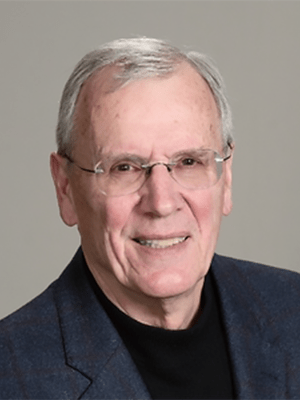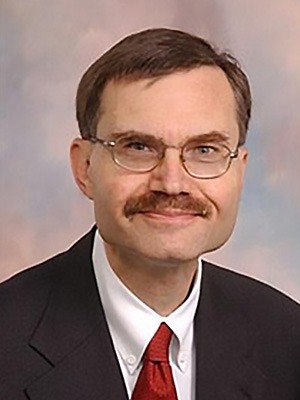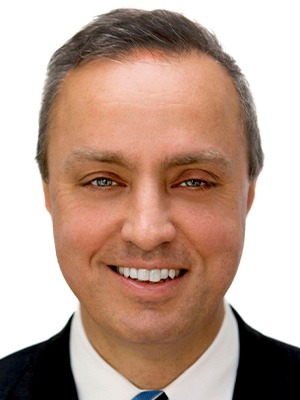University of Minnesota Residents Research Fund
Fund Purpose: To fund resident research in the Department of Neurosurgery at the University of Minnesota.

Lyle A. French, MD (1915-2004), was born on March 26, 1915 near Worthing, South Dakota. He received his premedical education at Macalester College in St. Paul and then attended the medical school at the University of Minnesota. After serving an internship at the University Hospitals, he began surgical training with Dr. Owen H. Wangensteen. When the division of Neurosurgery was created in 1940 under Dr. William T. Peyton, Dr. French became the first neurosurgical resident. He was in the military service from 1942 until 1946, serving in the 26th General Hospital in the Mediterranean Theater. Following military service, he completed his neurosurgical training. He obtained an M.S. degree and a PhD degree in Neurosurgery and was appointed to the staff in 1947. He was certified by the ABNS in 1948. In 1960, he assumed the Chairmanship of the Department of Neurosurgery, a position he held until 1972. From 1970 to 1983, he also served as Vice President of the University with responsibilities for the schools of the Health Sciences. He became Emeritus Professor in 1985.
His primary laboratory investigative interests were in cerebral edema; during his tenure the original studies were performed with the use of radioactive isotopes and the use of ultrasound for the localization of intracranial lesions. In the early 1960s, he initiated the use of steroids for the clinical control of cerebral edema. He also was involved early on with surgery to control epilepsy and for the care of patients with aneurysms and arteriovenous malformations.
His bibliography lists approximately 250 publications on various aspects of the neurological sciences. Many of his trainees became heads of departments in the United States and in the Far East.
Dr. French served on various advisory boards of the National Institutes of Health, the Veterans’ Administration, the National Paraplegia Foundation, and the National Advisory Commission on Multiple Sclerosis. He served on the editorial boards of the Year Book of Cancer, Modern Medicine, and the Journal of Neurosurgery (senior editor 1973-1975). He was a member of the board of directors of the ABNS from 1962 until 1968.
He was a member of numerous professional societies. He was President of the Minnesota Academy of Medicine (1964-1965), the Minneapolis Academy of Medicine (1966-1967), the Minnesota Society of Neurological Science (1964-1965), the Minnesota Society of Neurology and Psychiatry (1963-1964), the NSA (1957-1958), the AAcNS (1972-1973), the AANS (1973-1974). He has been a member of the ACS (Board of Governors), the American Surgical Association, Society of University Surgeons, the American Academy of Neurology, the American Neurological Association, the SNS and the Neurosurgical Travel Club.
French received a number of awards including the Neurosurgeons Award from the AAcNS, the Distinguished Service Award of the Society of Neurological Surgeons, the Harvey Cushing Award of the AANS, the Distinguished Services Award of the American Academy of Family Practice, the Outstanding Physicians Award of the Minnesota Academy of Family Practice, the Shotwell Award of the Minneapolis Metropolitan Medical Center and the Charles Bolles-Bolles Rogers Award of the Hennepin County Medical Society. He was the Honored Guest of the Congress of Neurological Surgeons in 1976.
Dr. French married Gene Francis Richmond in 1941. They had three children, Frederick, Eldridge and Barbara, and five grandchildren.

Donlin M. Long, MD, PhD, FAANS(L) was born in Rolla, Missouri in 1934, and his early years were divided between family farms in the Ozarks and their home in Jefferson City. In 1952, he entered the University of Missouri, and earned his MD in 1959. He served a surgical internship at the University of Minnesota (1959-1960), undecided between neurosurgery, neurology, and psychiatry as a career. There, a brief exposure to Dr. Lyle French convinced him to enter neurological surgery. He was accepted for a Residency at Minnesota in 1960. He started in the Anatomy Department under Dr. J. Francis Hartman, pioneer electron microscopist. This association culminated with a PhD in Neuroanatomy (1964). He was a resident in Neurosurgery at Minnesota (1960-64), and in 1965, was fortunate to secure a Chief Residency with Dr. Donald Matson at Children’s Hospital in Boston.
On completion of his residency, he went to the National Institute of Health as a Clinical Associate in the Branch of Surgical Neurology, where he entered the laboratories of experimental neuropathology, under the direction of Dr. Igor Klatzo (1965-1967). In 1967, he returned to the University of Minnesota as a junior faculty member, remaining until 1973, when he accepted the position of Chair of Neurosurgery at Johns Hopkins and became Neurosurgeon-in-Chief of the Johns Hopkins Hospital.
Dr. Long considers his most important scientific contributions to be in the area of brain edema. His original work was most important in establishing the ultra structural features of brain edema and the discovery of the open vascular junctions in human brain tumors which are responsible for the absence of the blood brain barrier. His important clinical contributions include the clinical studies which introduced gluco-steroid therapy for brain edema in association with French and Galicich and in the field of pain, where he introduced transcutaneous electrical stimulation in the medical practice and pioneered in the study of spinal stimulation for pain control.
Dr. Long founded the department of Neurosurgery at Johns Hopkins, founded the Department of Clinical Neurosciences through partnership with Neurology and planned the Adolf Meyer Clinical Sciences Center, which combines Psychiatry, Neurology and Neurosurgery. His experience with acoustic tumors was one of the largest in the world and his studies of the failed back syndrome provided significant insights into the reasons for surgical failure in the treatment of spinal diseases. Dr. Long retired as Chair in 2000 after nearly 28 years in that position. However, he continued his research interests and clinical practice.
Dr. Long retired from Johns Hopkins in 2010 and was named Distinguished Service Professor of Neurosurgery Emeritus. He also retired from his position on the staff of the Johns Hopkins Applied Laboratory. He maintained a part-time office only practice emphasizing spinal pain, and served as an industry consultant for products related to spinal pain until 2016.
From 2016 on, he focused his part-time practice on two clinical research projects, spinal and neurological issues in Ehlers-Danlos Syndrome, and clinical evaluation of patients with symptomatic Tarlov Cysts. In 2018, Dr. Long was named recipient of the Dandy Society Distinguished Achievement Award, and in 2019, he received the Who’s Who Lifetime Achievement Award.
Dr. Long passed away in September 2023, and is survived by his wife, Harriett Page Long (nee Kallenbach), whom he married in 1959, their children Kimberley Page Riley (Lee Hunter Riley III), Elisabeth Merchant Long, and David Bradford Long (Elizabeth Selvin); grandchildren Lauren Palmer Riley, Thomas Hunter Riley, Benjamin Logan Selvin Long and Eli Duncan Selvin Long.

Edward L. Seljeskog, MD, PhD, FAANS(L) was born on August 24, 1934 in Minneapolis, Minnesota, son of a physician-biochemist. He attended the University of Minnesota, where he majored in chemistry, receiving both the BA and BS degrees, followed by medical school at Minnesota (MD, 1959). He remained at Minnesota and while training as a general surgeon, he spent several months with William T. Peyton. His formal training in neurosurgery followed, under the tutelage of Lyle A. French. As a resident, he developed a close liaison with the Department of Anatomy and was awarded a PhD in Anatomy and Neurosurgery in 1971.
Upon completion of his formal neurosurgical training, he accepted a fellowship position in Oslo in the Department of Dr. Kristian Kristiansen. He returned to join the staff at Minnesota, where he established the first Neurosurgery Department at the Minneapolis General Hospital (now Hennepin County Medical Center). This undertaking flourished and continues to be a major component of the Minnesota Residency Program. In 1971, he returned full-time to the University Hospital where he developed an active clinical practice focusing on a number of areas.
He has spoken and written extensively on spinal trauma, particularly of the cervical region. Other clinical and research interests have included pituitary neoplasms, carotid-cavernous fistula and pediatric neurological surgery. In 1977, he was promoted to Professor and vice-chairman of the Department of Neurosurgery. He practiced in those capacities until 1993, when he “headed west” and entered private practice in Rapid City, South Dakota, with the intent of gradually retiring. His bibliography lists 54 papers and 21 book chapters.
In addition to his past active role in undergraduate neuroscience education and the neurosurgical residency at Minnesota, he involved himself nationally with graduate neurosurgical education, serving on the Neurosurgery Residency Review Committee and as a Director, and then Secretary of the ABNS where he continued to be called upon as a guest examiner.
He was active in a number of medical and neurosurgical organizations, including: The Minnesota Neurosurgical Society (founding President), American Medical Association (EMS Commission), ACS (Neurosurgery Advisory Council, Governor and Regent), CNS, SNS, and the AAcNS. Within the AANS, he served as a former Director, Secretary and President. He was a Captain in the U.S. Naval Reserve and served during Desert Storm.
In addition to his clinical practice, Dr. Seljeskog was involved with many organizational commitments. He maintained his ties to the University of Minnesota as Professor Emeritus, and along with his wife, Peg, was actively involved on boards of non-profit organizations in Rapid City and with philanthropic activities.
Dr. Seljeskog passed away in March 2022, and is survived by his wife, Peg, their five children: Steven, Eric, Vanessa, Sarah, and Christopher and five grandchildren.

Robert Eugene Maxwell, MD, PhD, FAANS(L), was born in Lima, Ohio, on June 24, 1936, the son of James Daniel and Ida Cox Maxwell. He received his undergraduate and medical school education at the Ohio State University in Columbus, Ohio, and was awarded a bachelor’s degree in 1958 and an MD degree cum laude in 1962. In 1957, he was elected to the premedical honorary society, Alpha Epsilon Delta, in 1960 he received the Nu Sigma Nu Outstanding Medical Student Award, and in 1961 he was elected to Alpha Omega Alpha. During medical school, he had the opportunity to work in the laboratory of Dr. Robert Zollinger and first learned operative techniques while constructing Heidenhain pouches for the study of gastric secretion and peptic ulcer disease.
He then interned and had his general surgery residency training with Dr. Alfred Blalock at the Johns Hopkins Hospital in Baltimore, Maryland. Dr. Maxwell’s first publication was a report on the results of the Blalock-Hanlon operation in 90 of Dr. Blalock’s patients with transposition of the great vessels. Upon completion of his general surgery training, Dr. Maxwell entered into military service and served two years as a Captain in the U.S. Army medical Corp. This experience stimulated his interest in surgery of the nervous system, and inspired him to pursue a career in neurosurgery.
He joined the training program at the University of Minnesota under Dr. Lyle French and an outstanding young faculty including Shelley Chou, Jim Story, and Don Long. Dr. Maxwell took graduate level courses in the neurosciences and taught gross anatomy and neuroanatomy to freshman medical students. As graduate student, he followed up on the pioneering works of the faculty on the use of steroids in brain edema and investigated the histological, ultrastructural, and biochemical effects of glucorticoids on experimental models of vasogenic and cytotoxic brain edema. He received the Degree of Doctor of Philosophy in 1974. That same year, he was certified by the ABNS and became a fellow in the ACS.
Dr. Maxwell joined the faculty of the University of Minnesota in 1971 and shortly thereafter was named Chairman of the Section of Neurosurgery at the Minneapolis Veterans Administration Hospital. He served as a Professor of Neurosurgery at the University of Minnesota and beginning in 1995, as Head of the Department of Neurosurgery, Chief of the Clinical Service and Residency Program Director. He also served as Chief of the Medical Staff at the University Hospital and Clinic from 1989-1994 and was a member of the University of Minnesota Health Systems Board of Governors and the University of Minnesota Physicians Board of Governors. His 95 publications reflected his research and clinical interests in cerebral edema, epilepsy, movement disorders, and pain. He served as president of the Society of University Neurosurgeons and President of the Minnesota Neurosurgical Society. In 1993, he received the Distinguished Alumnus Award of The Ohio State University.
Dr. Maxwell passed away in July 2022. In his life and career, he was particularly grateful for the loving support of his parents, wife Karen, and four children: David, Laura, James, and Carter.
To view a list of all donors to this fund, click here.
To support neurosurgery resident and fellow education in Africa.
To support the maintenance and future development of The Rhoton Collection® .....
To honor Dr. Allan Friedman and the RUNN Course.
To fund a fellowship or research grant for brain tumor research...




